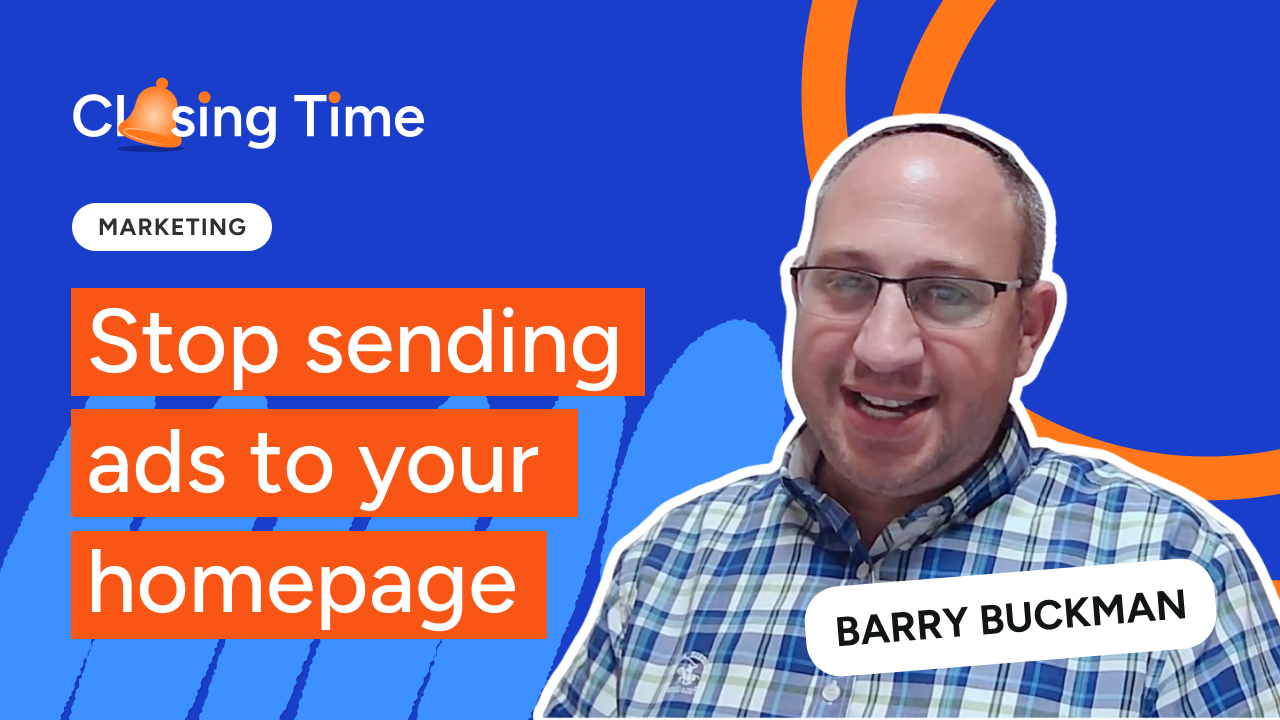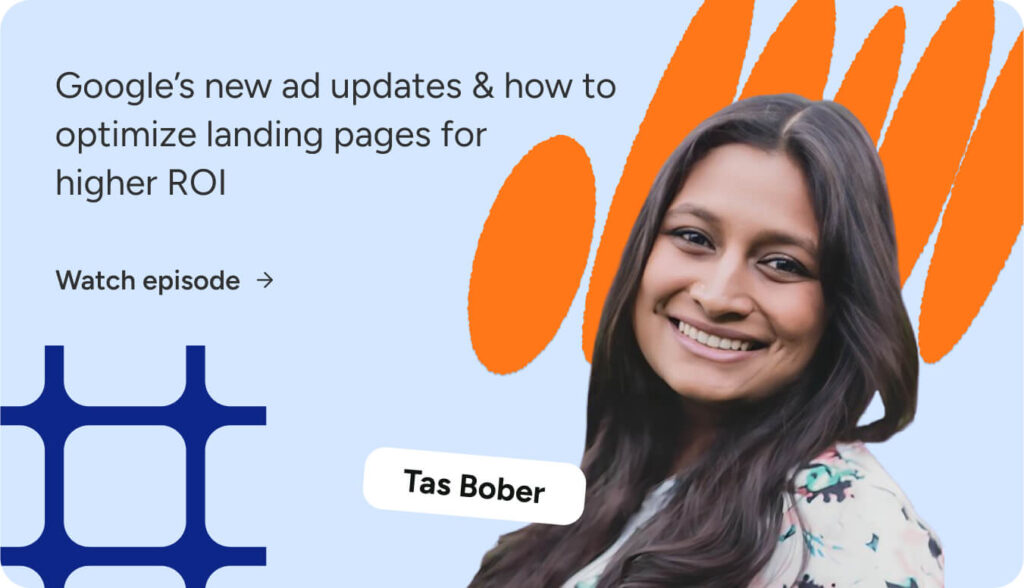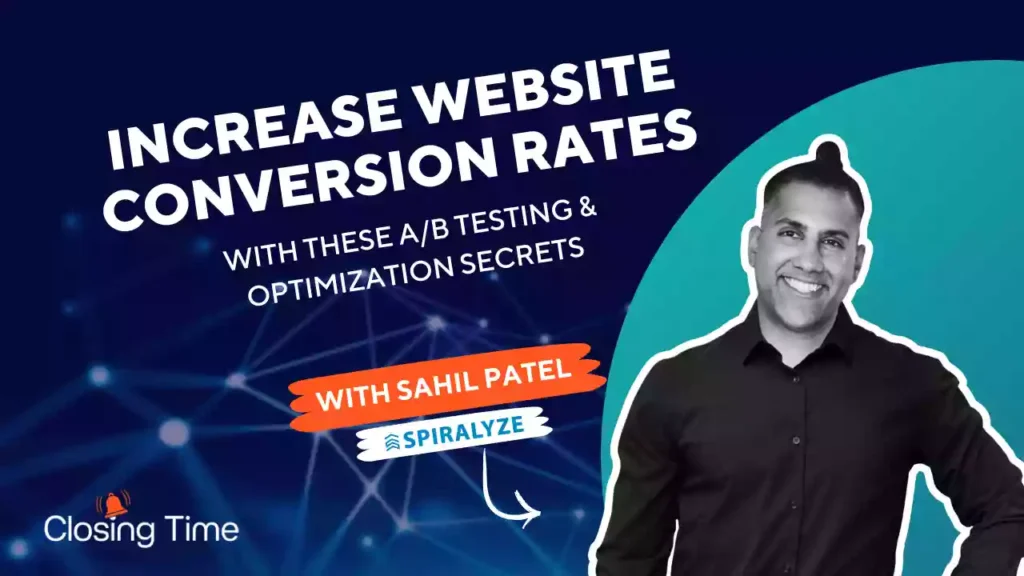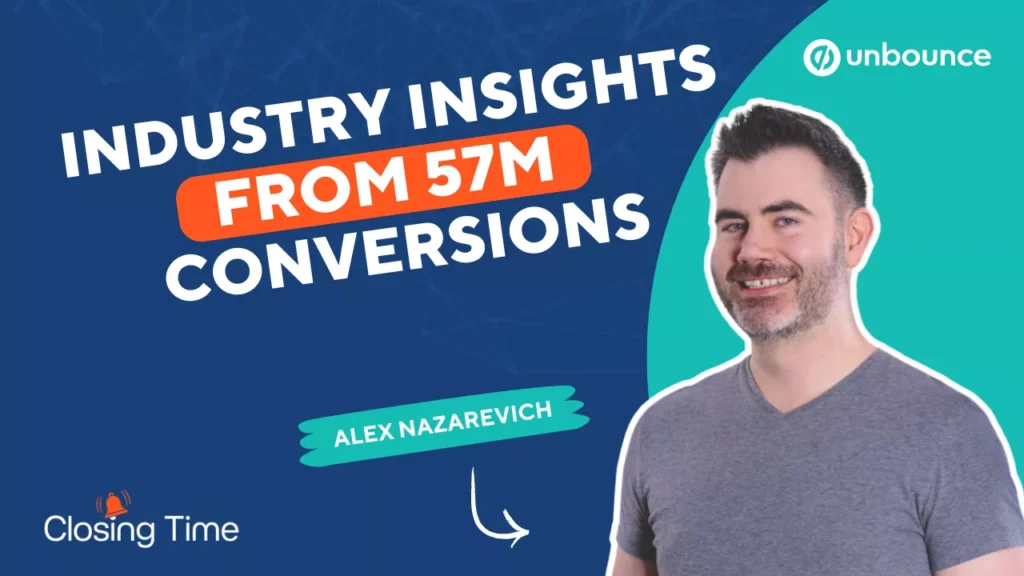When your ads and landing pages don’t match, conversions drop quickly.
Let’s talk about message match and smarter ad strategies
in today’s episode of Closing Time.
Thanks for tuning in to Closing Time, the show for go to market Leaders.
I’m Val Riley, head of marketing for Unbounce, Insightly, and LeadsRx.
Today I’m joined by Barry Buckman.
He is director of Client strategies at SunHouse marketing and co-founder
of SEMulator, which I’m excited to learn a little bit more later in the podcast.
Barry, welcome to Closing Time.
Hi, Val. Great to be here.
So you’ve been in digital marketing for 13 years.
Lucky 13 and you’re a Google Ads partner.
You know, the paid media space pretty well.
Can you start by sharing a little bit about your journey and how SunHouse
marketing helps clients? Sure.
So at SunHouse, we deal with all aspects of digital marketing,
but our sweet spot over the years has really become lead generation.
And in particular, paid lead generation.
Yeah, we do this through ad campaigns that almost exclusively run
ads to, Unbounce landing pages.
And that’s really also kind of a specialty of ours.
We’re not just into the accumulation of leads
because we know that not all needs are created equal,
but we’re really looking for valuable leads
that we know are going to move down funnel.
And, result in revenue for our clients.
I started at SunHouse in 2012, and I started using Unbounce
very early on during that time,. I would say, honestly, I pretty much
built my career on, you know, using,
you know, running ad campaigns that, that, that direct users to Unbounce pages.
And over the years,. I’ve tested many things and,
I’ve developed some techniques that I’ve seen have consistently led
to upswings in conversion rates and, you know, in turn,
increase profit, profitability in campaigns.
And, you know, one thing I’ll say is that when I got into, CRO
conversion rate optimization in general and Unbounce in particular, I felt like
it really sharpened the way I thought about digital marketing campaigns.
I thought that before that, you know, it was really hard to really get
a full grasp on the different types of messaging that you could roll out for,
for a client.
And, you know, once you start really digging
into the different types of messaging and how to integrate
that into your campaigns and on your landing pages,
it really sharpens things for you.
And, you start thinking on a much stronger level
about how you can get that, you know, that client to succeed.
Well, I’d be lying if I didn’t say how much we appreciate the love for Unbounce.
But sounds like you’ve built a really strong career in digital marketing.
So this stat might blow your mind.
We’ve shared it on closing Time before.
It still shocks me that 52% 52% of B2B
PPC ads send people to a homepage instead of a landing page.
So let’s talk about message match and why it’s so critical.
Sure. I’d love to.
So, you know, message match is the simple concept
that the ad messaging and the landing page messaging must match.
And when you do this, you see your conversion rates, improve.
And there are lots of stats out there
to show with this, but really, it’s common sense.
And really in this common sense, predates landing pages and predates the internet.
Like, you know, just imagine it’s like, you know, 1982
and you’re reading through your newspaper and you see in your newspaper
that there’s an ad and, you know, on like, you know, page four of the newspaper
about this, you know, offer at a local store.
And, you go to that store and you see that the offering
that they have does not match the ad that you read in your newspaper.
Obviously, you’ll be a lot less likely to purchase something from that store
that you know, this has been through in the 80s and the 1880s, 1780s, whatever.
And so it’s the same common sense concept
that’s been alive since the beginning of time.
And so really, you know, messenge matches, making sure that, users
see something in an ad and they get the same exact message
when it comes to the time to convert,
which in the age of digital marketing is the landing page.
Something I’ll say is that, you know, your real ad is your landing page.
You know, when, when Google or Facebook or whatever platform
you happen to be, running ads on talks about their ad.
The ad itself is an important but nonetheless glorified read more button
that is really the its job is to drive people to your landing page,
which is your real advertisement, because that’s when people
are going to decide whether or not they’re going to convert.
Okay.
And I think herein lies a very important point
that if you are running ads to your static home page,
which never changes, you’re really only running one ad, okay?
And that’s something that’s very, very, very important about,
landing pages even above and beyond the message matching.
Because if you’re only running one ad, then you’re really not
doing a whole lot to to optimize your campaign.
This I find to be the best way to sell
stubborn clients on the idea of using landing pages.
You know, often when you’re on,
when you’re following a prospective client, they’ll say,
you know, why don’t we need this landing page stuff for we have a good web site.
And I say, okay, but that’s just one, you know, as I told them, that
your landing page really is your ad and your website doesn’t really change.
And so that means that you’re only running one ad in your campaign.
Do you really want me to run an ad campaign that only has one ad?
And, they say no.
And this, this this tactic has never failed.
I’ve never gotten any objections to this whatsoever.
So, you know, I’d say that’s one thing that makes landing pages
really, really, really important.
And the other is, you know, message matching.
Because if you have three,
three different ads, let’s say, they all say different things.
And your home page only says one thing,
you know, it’s impossible to message match three ads to one home page.
So, you know, the importance of landing pages is can’t be overstated in this way.
So I love that analogy of the store front.
That one ad I think that’s great.
I think it’s really important to bring it down to a level
that people, clients can understand.
So brilliant tactic there.
I feel like this ties back to this most recent policy update that Google issued.
It was back in February,
and they rolled out this ad prediction model
and it really doubled down on message match.
And navigation.
So was that surprising to you
or are you like, okay, they’re finally catching up here.
Yeah. I’ll tell you the truth.
I was actually in a very good way, shocked when I heard about this.
It really showed me that Google
is, taking message match seriously.
And the reason I say I’m shocked is because that seemed to me
and other marketers that, you know, for the past number of years,
Google has kind of inadvertently but nonetheless definitely,
been waging a war on message match, you know, with responsive
search ads, you know, as you might know, like, you know, back
five, six, seven years ago, search ads were a pretty simple thing.
You told Google
exactly what you wanted your ad say, and that’s what your app would say.
Then they rolled out responsive search ads at some point where they give you,
you know, you can provide a list of up to 15 different headlines
that Google can mix and match into your ad.
And, Google decides, you know, through its own intelligence
whether which, which of those headlines it wants to show.
This obviously could be good for certain things,
but it’s definitely not good for message matching when you want to make sure
that your ad and your landing page, match up.
So, you know, and obviously you, you know, as you might know, you can
you can pin your ad, you can pin certain headlines and descriptions in your ad.
But then you know what happens.
Then Google, just all of a sudden
says your ad quality is poor, which, you know, doesn’t make us very happy.
So yeah, like, you know, just to get back to the point,
yeah, I was really, really happy to see that they’re taking a step
that actually takes message matching seriously.
You know, just to make sure we get back to that basic common sense
that’s been alive since, you know, since the beginning of advertising.
yeah, I love that take.
I didn’t even see it through that lens when
when Google was trying to optimize for us.
Sometimes it may have taken us away from the exact meaning of the landing page.
That’s a really good point.
Maybe they are finally, finally learning.
So, as marketers, you know, testing is a big part of optimization.
Can you talk about how you use A/B testing to drive results for clients?
And is it something, again where you have to get,
give clients a reason to allow you to do A/B testing on their accounts?
I would say, so, so A/B testing is, you know, it’s really core
to, to increasing conversion rates and increasing profitability.
You know, I think once you sell, once you sell the clients
on the idea of running different ads and different landing pages in particular,
they’re happy to see, you know, you come up with new ideas,
new messaging, ideas that you can roll out and in your ad campaigns.
Sometimes I’ve seen that, you know,
if you want to give a campaign that seems to be kind of, you know,
static, like a good shot in the arm.
The best way to do this sometimes is by rolling out
some completely new messaging that you hadn’t tested before.
And that can really only be done.
You know, through landing pages on, on the landing page level.
So, you know, I’ll explain now
the exact method that I use
when I’m doing A/B testing, on my, in my ad campaigns
and insert on my landing pages and, just as a sneak peak,
you know, the Google ad simulation tool that we’ll talk about in a few minutes
is a really great way to practice this and to really get the process down.
Okay.
So what. I find to be the best way to do this
before you even start on your ad campaign is to,
you know, with, together with the client, develop 2 or 3 value
propositions that you want to test in your ad campaigns.
Two, three value propositions that, you know, really,
you think could be really good sellers, for your target market.
And I’m saying a maximum of three, because, as you might know, Google
only allows right now, three responsive search ads, in any given ad group.
So you want to make sure
that, you know, you have all of these tested in that ad group.
Okay.
So once I have those, you know, those,
let’s call it three value propositions that I want to test.
I don’t even go yet into the ad account.
First, I go in to Unbounce and I create
2 or 3, you know, let’s say five, three
Unbounce landing pages, one for each value proposition.
Okay.
What’s really important here
is that I’m not talking about different variants in one, Unbounce page.
I’m talking about three different
on Unbounce pages one and Unbounce page for each value proposition.
Okay.
And then I create three different ads, one ad for each
landing page, one ad for each landing page, one ad for each landing page.
Okay.
So for example, if you have one ad, one site, let’s say
one landing page where the mean value proposition is, hey, come to us.
We’re very affordable.
You want to make sure the ad says we are very affordable.
That’s on one landing page URL, on the next landing page URL,
come to us because we have really fast service.
That’s what the ad should say.
Okay.
You should call this your ad and landing page battery.
Okay.
You don’t want to A/B test different variants with different
messaging on the same landing page URL because this messes up your message.
Okay, so really, when you’re doing A/B testing that the core thing
you’re doing is actually testing, not the variance of the landing page,
but the ad landing page batteries that you have.
And you’re going to have 2 or 3 of those.
Okay.
So then you might ask when you’re actually doing A-B testing on different variants
within your landing page, you can have, you know, as many variants as you like.
What are you really testing there?
And my answer to that is anything other than the messaging.
The core messaging on those variants has to stay the same.
Okay.
But you can definitely test things like visual
elements, long pages versus short pages.
You know, one thing I love to do is to, you know, spend
lots of time creating a really, really, really long landing page.
And then, creating a new variant where I just chop off half of it
and, you know, and A/B test that and see which one converts best.
Also testing different types of forms, different, you know,
different, elements that you’re, that you’re collecting in the forms.
Anything that’s not related to messaging,
that’s what you should be testing on the variant level.
But make sure that the main testing that you’re doing is the different add
to landing page batteries.
And you can do this in Google, Bing,. Facebook, LinkedIn, whatever.
It’s the same. It’s the same process.
I love it.
Thank you.. Thank you for sharing your, your method.
I think a lot of folks are going to benefit from that.
So speaking of folks that could benefit, let’s talk about junior marketers,
because a lot of times you have young people trying to break in
the field and getting hands on experience with an ad set
usually means spending actual budget and that’s very risky.
I know, for instance, when I look at our paid media,
I want that in the hands of someone who’s super experienced.
But, you know, we all know that you learn by doing.
And so you have a really neat workaround for this.
Let’s talk about it.
Yeah. Sure.
So you know, I’m going to ask a rhetorical question
to everybody out there.
My rhetorical question is, whenever you get on the plane,
you can rest assured that the pilots
who are flying in that plane have already trained in simulators
for many, many, many hours before getting hired by the airline.
And, you know, my rhetorical question is, does this make you happy?
And I’m sure that 100% of people will answer, yes, this is a good thing.
Okay.
All data everywhere shows that the best way to learn
is through simulation and repetition.
And simulation is much more effective and a much more effective way
to learn than just learning in theory alone.
Okay, and yet, digital marketing simulators don’t exist
up until now, but let’s just say they have not existed until now.
And digital marketers are spending zero hours in flight simulators before flight,
okay?
And then they get hired and they’re flying the plane.
This results in clients
paying for the junior marketers learning the learning curve.
Okay.
If I, if a junior marketer is learning is is managing a campaign
and they simply don’t have the experience they’re going to learn
by spending their clients money.
This is a bad situation for the client, for the marketer itself itself, for the,
you know, for the agency. Okay.
Because they’re just not ready to manage these campaigns
because they don’t have the experience.
As all experienced digital marketers know, what is experience?
It’s the sweat it’s staring at into a dashboard of results
that you know you need to improve and then knowing how to improve it.
And this can only be learned through years of experience
while spending thousands of dollars in ads.
That’s up until now.
Or through a simulator.
Okay.
And simulation tools for digital marketing don’t exist until now.
Well, so I feel like that’s the best set up for what you call the SEMulator.
Great name, by the way.
Tell us how you developed this tool and what it allows, people to do.
Sure.
So, the SEMulator okay, is a Google Ads flight simulator.
Okay.
This gives, users, the beginners or even experienced marketers
who still want to practice their, their, you know, their skills,
the ability to do exactly what digital marketers do every single day
in a risk free environment without spending a dime on ads.
Okay, so in the SEMulator, you get the experience of building,
managing and most importantly, optimizing
ad campaigns without spending any money on ads.
You choose your landing page copy, you choose your keywords,
negative keywords, match types, ad copy,
all the key elements.
Okay?
And then the most important thing is you actually press go
and the system provides you with simulated ad results.
And then what happens okay, you get a dashboard, full of real metrics,
spend clicks, conversions, conversion rate, the works.
But this all happens in a risk free
simulated environment without spending any money on the ads at all.
Okay.
And this gives you the experience of analyzing these metrics, looking
looking at the dashboard, of a campaign that might not be performing up to par,
seeing what needs to be fixed, and then actually fixing it,
because then you can make adjustments to your campaign,
run the campaign over and over again until you get the results that you want.
Okay.
So this is you know, as we all know, this is exactly what digital marketers
do every single day.
And in the real world,
we’re spending thousands of dollars of their clients money on that.
This gives you the experience to do this in, in a virtual environment.
Okay. So how does this help people?
So first of all, it helps.
It helps through simulation and repetition okay.
The simulation is really, really key for beginners
who usually come into, into their jobs without any real experience.
Okay.
And this will help beginners know which levers to pull to improve a campaign.
It’s also a really great training tool for agencies.
I like to think about this.
If you’re familiar with the movie, the,. The Karate Kid.
I like to think of the SEMulator as the Mr.
Miyagi, digital marketing.
But didn’t Mr. Miyagi do?
He taught Daniel karate through a repeatable process.
Wax on, wax off.
Repeat, repeat, repeat.
All day, all night. Wax on, wax off.
And the next thing you know, Daniel’s in the karate tournament.
And he knew exactly what to do because he learned the repeatable process.
Okay.
And the best way to learn is, is by burning a repeatable process
into your brain.
And the SEMulator does that.
It’s really, really fun.
And I think you and you know, and your employees will definitely enjoy it.
Yeah.
Some of my, dry humor,. Google ad training videos in there, too.
So I think, you’ll really enjoy and enjoy that as well.
I just kind of want to say thank you on behalf of marketing leaders all over,
because so often we have young people come to us and say, well,
how do I get started? How do I try?
And tools like this are just a great way to give them something.
Okay. Go here.. And this is something you can learn.
I like to know that my whole team understands
what’s going on in media buying.
Certainly we have people that specialize in that.
But you know, the person who’s writing the landing page
and the person who’s designing the landing page, it’d be great if they understood
how their work fits into this process in a risk free way.
For sure.
You know, like, I’m in a bunch of different, you know, Google
and Facebook groups and, LinkedIn groups and I, you know,
oftentimes I see beginners asking, you know, what’s the best way to learn?
And this is. I believe this is, you know, learning
through simulation is the best way.
And and so this is the can be the best way to learn.
Awesome. Barry, this conversation has been great.
Thank you so much.
Where can people go if they want to find out
more about SunHouse marketing and then certainly to get their hands
on the SEMulator. Sure.
So for SunHouse marketing for, you know, anything you need as far as digital
marketing is concerned, you can you can visit us at SunHousemarketing.com.
The SEMulator
you can visit us at MySEMulator.com okay.
SEMulator is spelled just like the word simulator
only the SEM instead of SIM, so it’s mySEMulator.com.
If you have any questions, or about either of these, please
just, reach out to me on LinkedIn.
I’ll be happy to answer all your questions.
Personally, I’m the Barry Buckman who is digital and digital marketing,
not the architect who designs in Portland,. Oregon.
Barry, thanks so much for joining us today.
Okay. Thank you very much.
And thanks to all of you for tuning in to Closing Time.
Remember, you can get this episode delivered right to your inbox.
Just click the link in the show notes.
We will see you next week.




